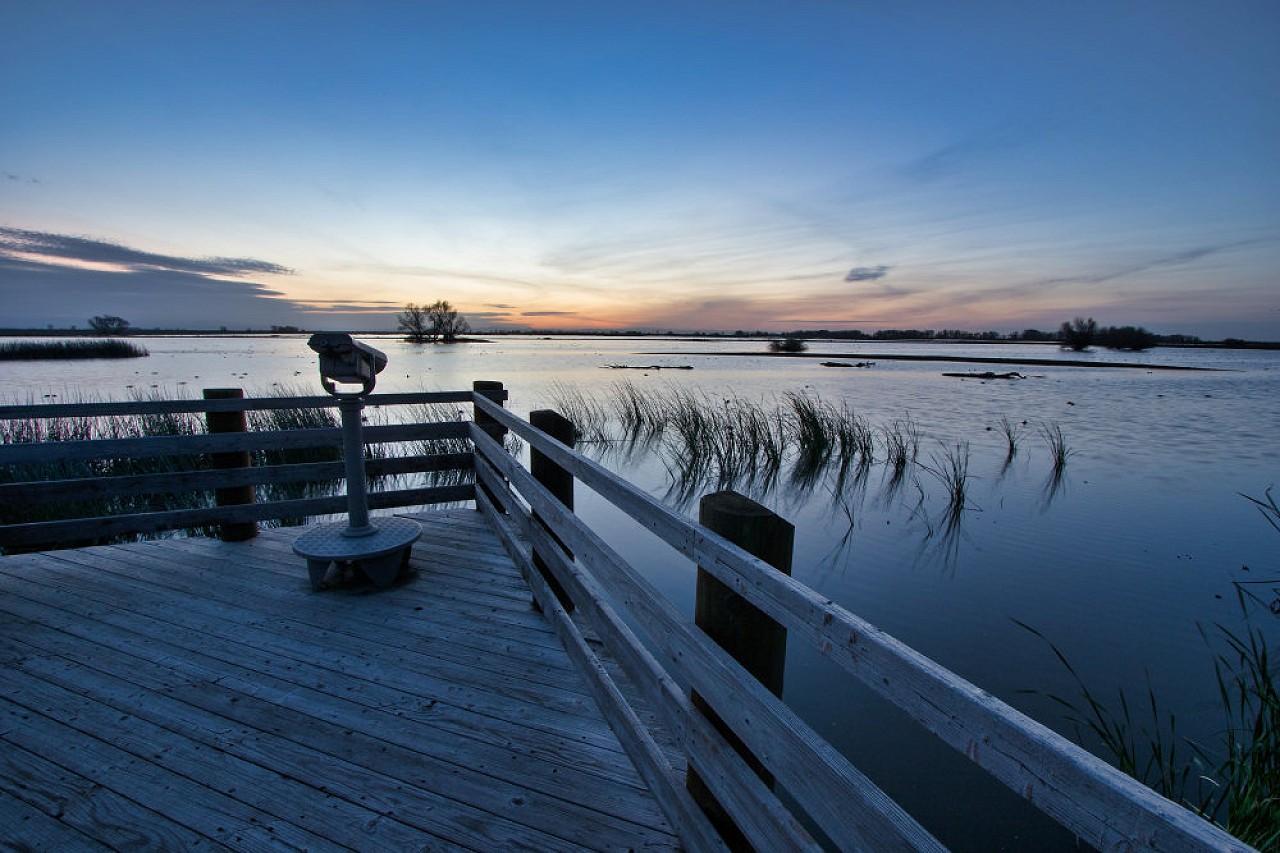


The Merced National Wildlife Refuge encompasses 10,262 acres of wetlands, native grasslands, vernal pools, and riparian areas in California. It was established in 1951 under the Lea Act to attract wintering waterfowl from adjacent farmland where their foraging was causing crop damage.
The Merced National Wildlife Refuge encompasses 10,258 acres of wetlands, native grasslands, vernal pools, and riparian areas. It was established in 1951 under the Lea Act to attract wintering waterfowl from adjacent farmland where their foraging activities were causing crop damage. In the last few decades, changes in local agricultural practices and Refuge management activities have reduced these wildlife/crop issues.
The Refuge plays host to the largest wintering populations of lesser Sandhill cranes and Ross’ geese along the Pacific Flyway. Each autumn more than 20,000 cranes and 60,000 arctic-nesting geese terminate their annual migrations from Alaska and Canada to make the Refuge home for six months. Here they mingle with thousands of other visiting waterfowl, waterbirds, and shorebirds – making the Refuge a true winter phenomenon.
The Refuge also provides important breeding habitat for Swainson’s hawks, tri-colored blackbirds, marsh wrens, mallards, gadwall, cinnamon teal, and burrowing owls. Tri-colored blackbirds, a colonial-nesting songbird, breed in colonies of more than 25,000 pairs in robust herbaceous vegetation. Coyotes, ground squirrels, desert cottontail rabbits, beaver, and long-tailed weasels can also be seen year-round.
Vernal pools are unique and special wetlands found on the Merced NWR. These special pools form when natural shallow depressions underlaid with clay soils fill with winter rainwater. The pools come to life as they fill with water: fairy and tadpole shrimp emerge from cysts embedded in the soils the year before. The endangered tiger salamander, along with other amphibians, lay eggs and rear tadpoles. The vast number of aquatic invertebrates found in these pools provides a food source for wintering and migrating birds as they prepare for the long flight north to their breeding grounds.
As spring arrives and the water in the vernal pools evaporates, wildflowers such as goldfields, purple owl’s clover, and butter-and-eggs germinate in colorful patterns of thick rings or halos around the pool basins. Once the vernal pools have dried out, Downingia and Colusa grass, a rare California species, appear in the parched basins. This annual floral display of color led John Muir to describe the valley floor as the “floweriest part of the world” he had seen.
In addition to managing natural habitats, the Merced NWR contains approximately 300 acres of cultivated corn and winter wheat crops and more than 500 acres of irrigated pasture for wildlife. Not only do these managed agricultural areas provide important sources of carbohydrates for the tens of thousands of arctic-nesting geese and Sandhill cranes that make Merced County their winter home, they also help ensure that the birds will have adequate nutrient stores to make the long migration north to their breeding grounds. Local farmers, under agreements with the Refuge, oversee the ground preparation, seeding, and irrigation of these croplands. The Refuge incorporates a livestock grazing program that works in partnership with local ranchers and farmers. Cattle grazing is a management tool used by the Refuge to provide and maintain short stature grasslands and help control invasive weeds. Grazing also encourages native grasslands and the species that depend on them to thrive.
Located on over 10,000 acres of wetlands and native grasslands, the Merced National Wildlife Refuge welcomes an influx of migratory waterfowl during the winter months. This land was set aside as a refuge in the 1950s, in an effort to entice the migrants away from adjacent farmland, where they were causing extensive crop damage. Today this off-the-beaten-path stop offers a number of wheelchair-accessible trails, as well as an auto loop, where visitors can get an up-close-and-personal look at the winter visitors.
Hike the Cottonwood Loop
The Cottonwood Loop trail makes a a good first stop at the refuge. The trailhead is located on the right side of on Sandy Mush Road, just past Lonetree Road. Be on the lookout for the brown “Merced National Wildlife Refuge” sign that marks the entrance to the small parking lot.
Although the parking lot is dirt, there’s accessible parking on a cement pad near the trailhead. The Cottonwood Loop skirts the adjacent grazing land, and circles through a cottonwood grove. It’s prime prime raptor habitat so keep your eyes peeled for Red Tailed Hawks, Swainson’s Hawks and Red Shouldered Hawks. It’s also a favorite nesting spot for Great Horned Owls. The 1.1-mile hard packed dirt trail is level, and although you’ll have to dodge a gopher hole or two, that’s pretty easy to do on the wide pathway.
About halfway along there’s an accessible observation platform which looks out over the grassland, where you may spot a Sandhill Crane or two. During the winter it’s also easy to see flocks of Ross’s Geese circling overhead. And if you fancy a secluded spot for lunch, there’s an accessible picnic table on a cement pad right next to the observation platform. From there the trail continues through the cottonwood grove and winds back to the parking lot.
Although the Cottonwood Loop is detached from the main part of the refuge, that’s also part of its beauty. Most folks zip right on by it on their way to the more popular Auto Loop, so it’s not unusual to have the whole trail to yourself. Plan ahead though, as there are no restrooms or other facilities at this stop.
Drive the Auto Loop
The Auto Loop and the main part of Merced National Wildlife Refuge are located about a mile down Sandy Mush Road, on the left side. There’s no visitor center at the refuge, but there is a small information kiosk next to the beginning of the Auto Loop. Accessible vault toilets are also located next to the picnic area which features accessible tables on a covered cement pad. Additionally, there’s ramped access to an observation platform that’s located next to the accessible parking spots.
The five mile driving loop begins just past the picnic area. Along the way birds and waterfowl line both sides of the road. There’s plenty of room to pull over and watch all the activity, and there are even some interpretive panels along the route to help with identification. It’s an excellent way to explore the refuge, especially if you can’t manage a hike. And there’s no shortage of eye popping wildlife views along the way.
Explore the Marsh
Although walking along the Auto Loop is prohibited, the Bittern Marsh Trail is located about halfway along the route. Even if you can’t manage the whole trail, it still makes a nice stop on the Auto Loop.
There’s no accessible parking in the dirt parking area, but it’s possible to parallel park an adapted van in the designated parking areas. Accessible vault toilets are located near the trailhead, and there’s also an accessible observation platform across the street. Even if you can’t manage the trail, be sure to check out observation platform, as it offers an excellent view of the thousands of Ross’s Geese that winter in the marsh.
The hard-packed dirt Bittern Marsh Trail begins across the street. It winds through the wetlands, and offers a peek at the marsh birds, and perhaps the occasional raptor or two. About a quarter-mile down the trail there’s an accessible picnic table on a dirt pad, and since it’s tucked away off the trail it offers plenty of privacy. As you round the loop be on the lookout for the large flocks of geese that take off and circle the marsh. They’re had to miss, as their calls are thunderous as they fly overhead. All in all this one-mile trail offers a nice break along the Auto Loop and gives visitors an even closer look at the avian residents.

